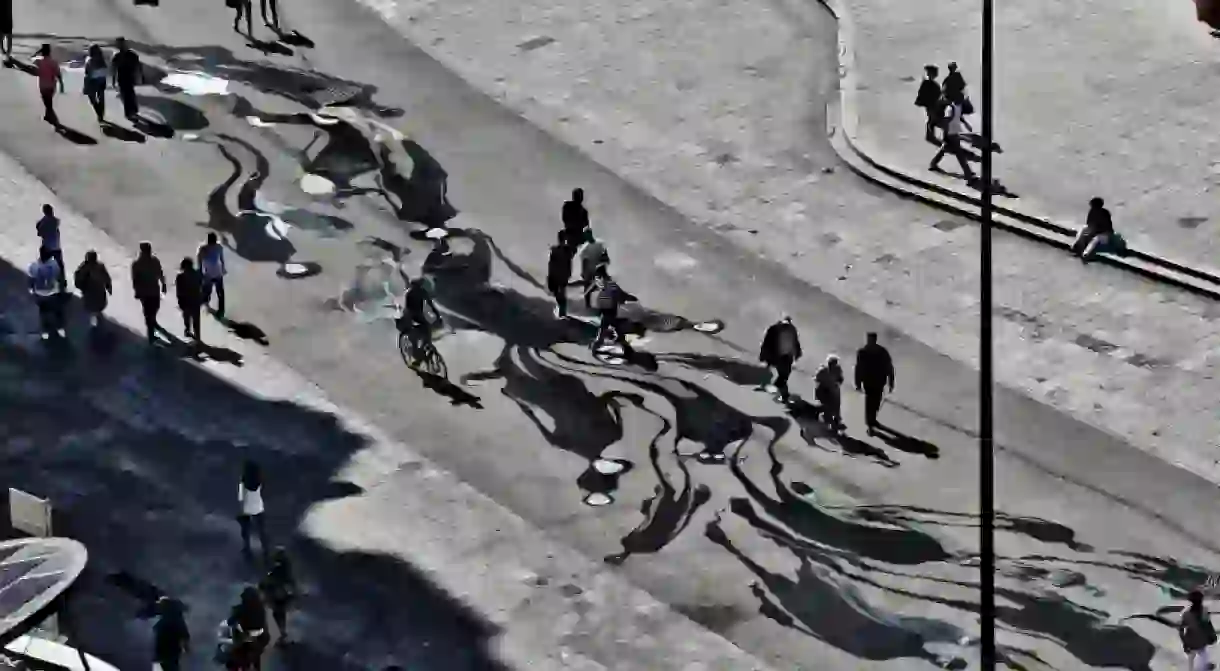Brazilian Streets Artists Transform Frankfurt's Streets

Brazil’s vibrant street artist’s gets a new canvas for experimentation as Frankfurt’s Schirn Kunsthalle brings artists from São Paulo and other Brazilian cities to transform the streets of Frankfurt. Culture Trip profile the artists who have left their indelible mark on Frankfurt’s buildings, hardings and even trams.
Speto
The stories Speto tells in his murals are inspired by the north-Brazilian tradition of Literatura de Cordel. The point of departure for Speto’s painting on the façade of the St. Matthäus Church in Frankfurt is a Cordel poem written by the artist about a bizarre day in the life of a “motoboy”. Paulista use this term in reference to the roughly 220,000 bicycle couriers in the city, many of whom lose their lives on daily trips through the heavy urban traffic.

Zezão
Zezão’s blue, ornamental arabesques derive a strong social component from the settings in which they appear. They lend a peculiar beauty to some of the poorest and most derelict quarters of São Paulo. His arabesques not only cover flat walls, they wrap themselves three-dimensionally around objects in their environment, such as the ruins left behind by fire in the Favela do Moinho. In Frankfurt, Zezão’s works grace the dark corners of the Untermain Bridge and draw attention to the ceiling in the east arcade to the Schirn building for the very first time.

Nunca
Nunca gives expression to the Brazilian roots of his paintings in his works presented in Frankfurt. On the firewall of the building at Niddastraße 64, he is painting the sequel to a mural painted in São Paulo in August 2013 in the original scale. His figures are composed collage-style from indigenous and African motifs and elements of contemporary everyday Brazilian and European consumer culture.

Gais
The hoarding around the Stadthaus construction site that runs alongside the Schirn building is the setting for vividly coloured works by Gais. The theme of his geometric paintings is the invisible world that lies behind things. By placing abstract paintings in the Favelas of Rio de Janeiro, he exposes this painting style, which is associated with high culture in the field of visual art, to a broader public.

Jana Joana & Vitché
Dream worlds populated by fantastical beings play a major role in the paintings of the artist duo Jana Joana & Vitché, who have been working together for fifteen years. Their clowns, harlequins and birds shape the face of the entire Cambuci district in São Paulo, where Vitché was born and the two artists live today. Vitché is one of the pioneers of the Brazilian scene, and stands out from the international scene with his works in the style of folk art.

Herbert Baglione
Herbert Baglione achieved the transition from his image as a graffiti-writer to that of a street artist in 1997 by disseminating a written message in the streets of São Paulo announcing that his pseudonym “Cobal” was dead. Since then, he has worked under his real name, and paints primarily ghostly-looking creatures on streets and pavements – figures that relate to the buildings and physical features in their surroundings.

Onesto
Onesto’s works reflect spontaneous situational encounters with pedestrians. Onesto inscribes the events that unfold in the microcosm of the city into just such places, thereby attracting the critical attention of viewers to political or social issues. His work in Frankfurt will appear on two buildings on Neue Mainzer Straße 57 and 59.

Alexandre Orion
In his “Ossario” (graveyard) project, Alexandre Orion does not merely use the exhaust-blackened walls of a tunnel São Paulo as the substrate for his intervention. The series of skulls that extends over 300 metres of wall was created by wiping away the accumulated soot. Thus the wall scarred by air pollution is the sole material for his painting. Orion adds nothing to the city; he draws from it.

Fefe Talavera
Before public advertising was officially banned in São Paulo in 2007, Fefe Talavera used posters and billboards as points of intervention. Today the artist prints her own letters and combines them in large-scale ‘monster paintings’. Talavera’s figures call to mind brightly coloured Alebrijes – paper-maché figures of the kind originally created by Pedro Linares in 1936 and inspired by fantastical dreams – which have since become an integral part of Mexican folk art.

Rimon Guimarães
Born in Curitiba in 1988, Rimon Guimarães views the act of painting on the street as performance. The city is his stage, passers-by his audience. He accompanies his spraying with dance, vocals and music, which he produces himself with the aid of such everyday objects as buckets or bicycle bells and with his own voice. His large, brightly coloured mural can be seen on the hoarding at the construction site of the former KfW building at Bockenheimer Landstraße 102-104.

Tinho
The countless abductions of children in the 1990s are the theme of Tinho’s paintings. He presents images of bound, weeping and fearfully crouching children based on photos from missing person ads and search queries on tomato packages or milk cartons. Some of his figures appear alone beneath city rail tracks, in front of garage doors or behind bushes, as if they were actually present at these places in the city.

Onesto and Tinho
In collaboration, Onesto and Tinho paint an entire Frankfurt subway train. With this work, the two artists address yet another aspect of the graffiti scene, in which collective undertakings play a crucial role.














